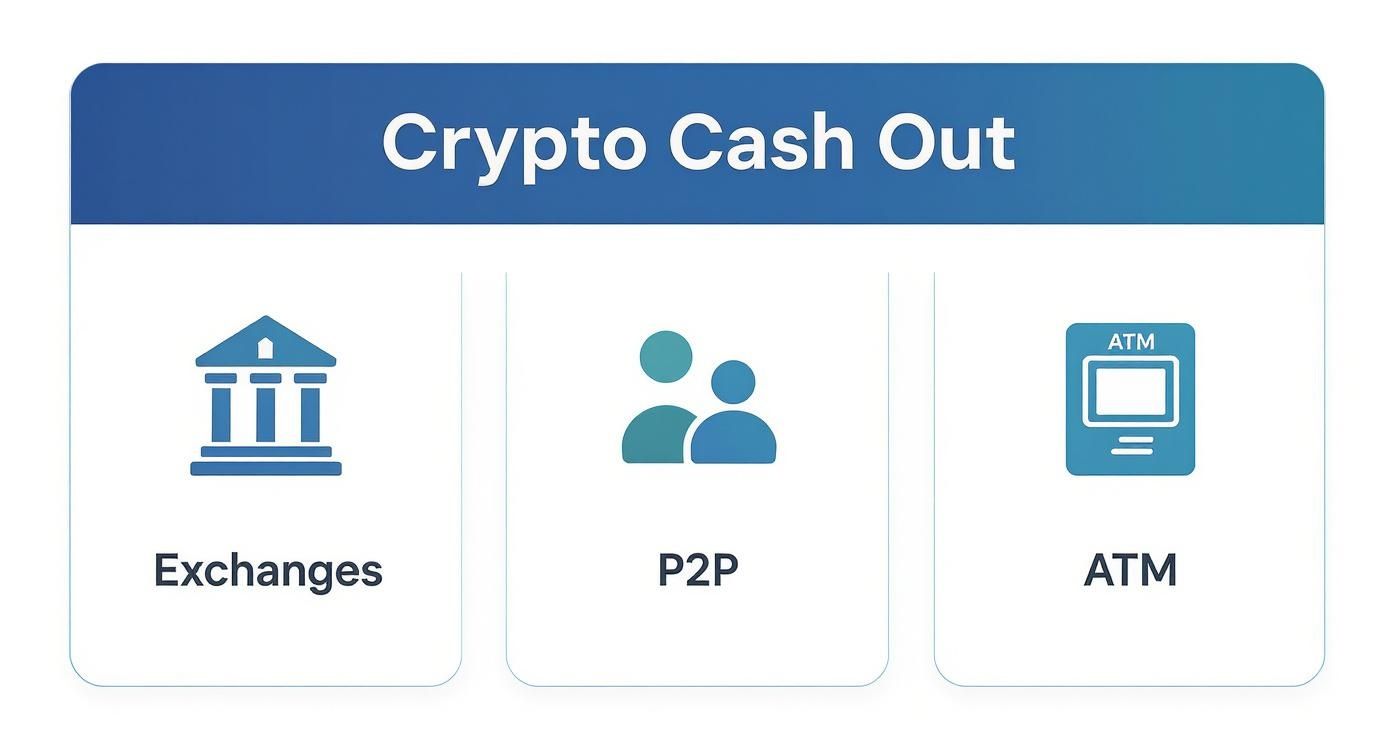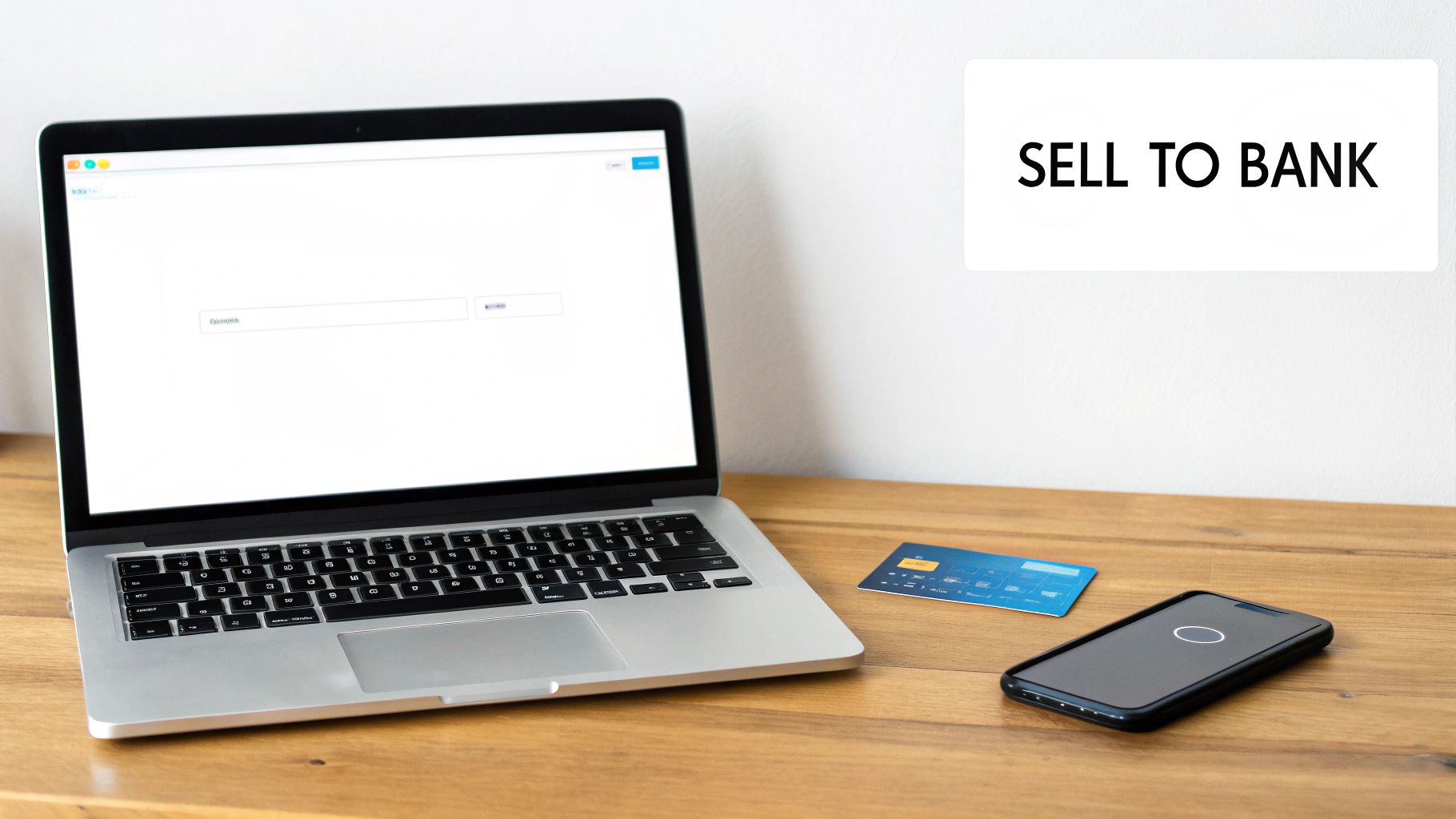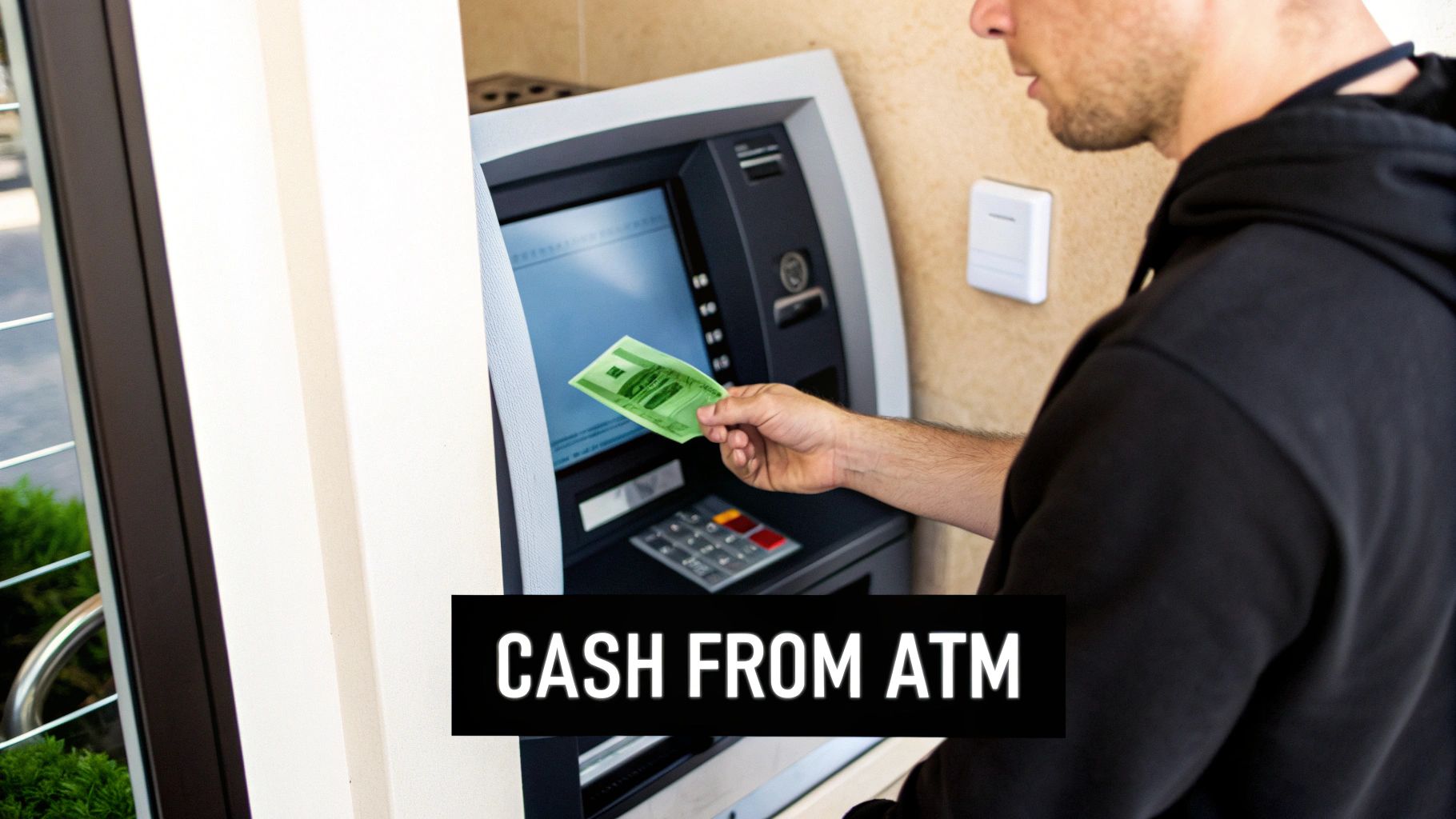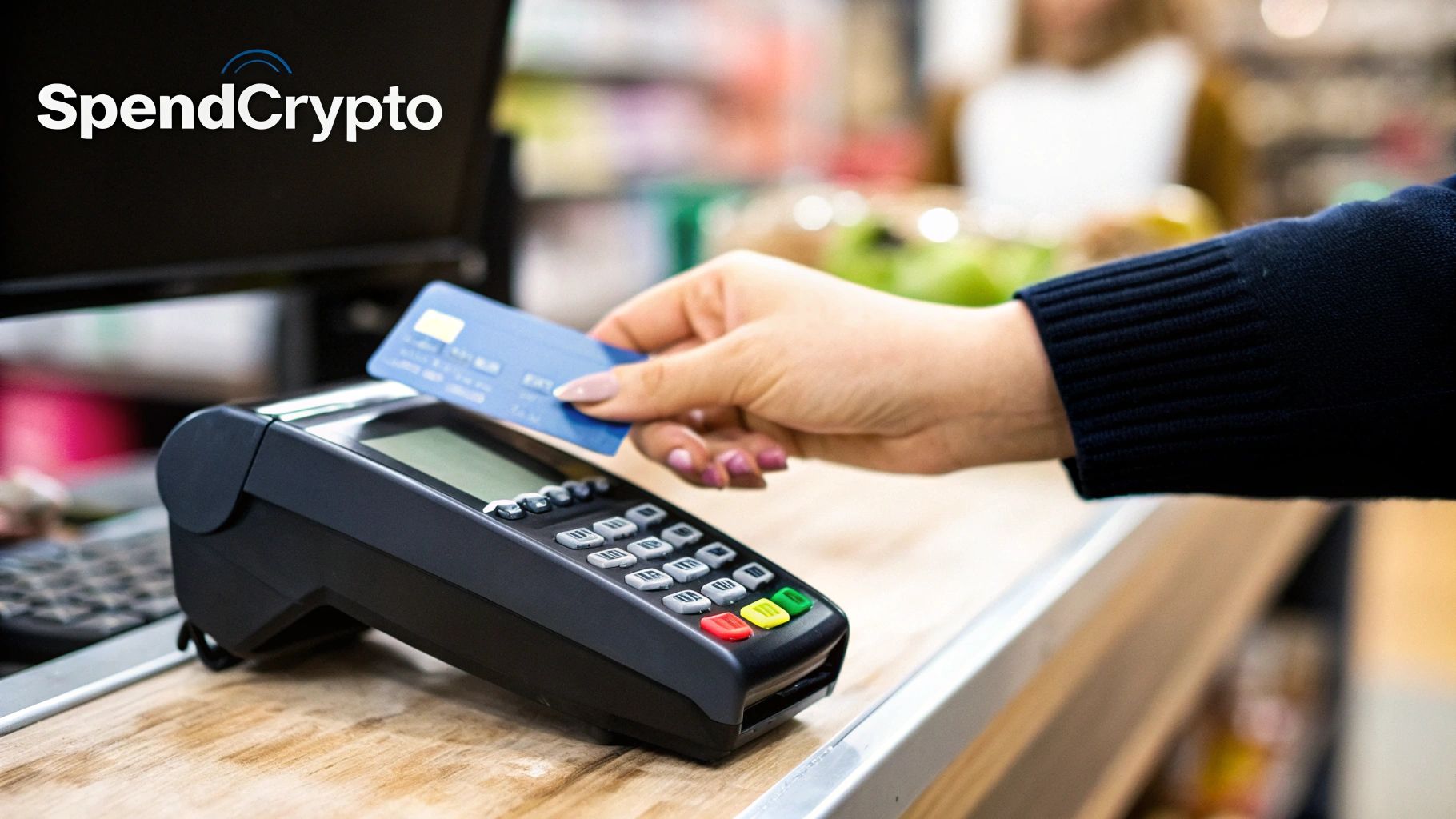
how do you cash out on cryptocurrency: Quick Withdrawal Guide
So, you've made some gains or just need to use your crypto in the "real world." The big question is: how do you turn those digital coins into cold, hard cash? Cashing out simply means converting your cryptocurrency, like Bitcoin or Ethereum, into a government-issued currency (fiat) like US Dollars or Euros that you can actually spend or pop into your bank account.
There are a few well-trodden paths to get this done. The most popular routes are through a centralized crypto exchange, a peer-to-peer (P2P) platform, or even a specialized crypto ATM. Each option strikes a different balance between speed, cost, and convenience.
Your Quick Guide to Turning Crypto into Cash
Let's break down the most common ways to cash out your crypto holdings. Think of this as your roadmap from digital assets to spendable money. We’ll cover everything from straightforward bank transfers via major exchanges to the flexibility of P2P platforms and the instant gratification of a crypto ATM.
This infographic gives you a great visual starting point for the main methods people use.

As you can see, exchanges offer a solid, all-around option. P2P trading introduces more flexibility, while ATMs are all about speed.
Crypto Cash-Out Methods at a Glance
Choosing the right path often comes down to your specific needs. Are you cashing out a large amount, or do you just need a few hundred dollars right now? This table breaks down the key differences to help you decide.
| Method | Best For | Typical Speed | Common Fees |
|---|---|---|---|
| Centralized Exchange | Large amounts & bank transfers | 1-5 business days | Trading & withdrawal fees |
| Peer-to-Peer (P2P) | Flexible payment methods | Varies (minutes to hours) | Platform & payment fees |
| Crypto ATM | Small, fast cash withdrawals | Instant | 7-20% of transaction |
Each method has its own rhythm. For instance, using a centralized exchange like Coinbase or Kraken usually means completing a KYC (Know Your Customer) verification, sending your crypto to the exchange wallet, selling it for fiat, and then withdrawing the funds to your linked bank account. The sale itself is fast, but waiting for the bank transfer can take a few business days.
The best method really boils down to your priorities. If you need cash in hand within minutes and don't mind the higher fees, a crypto ATM is unmatched. For larger, more secure transactions where you can wait a bit, a trusted exchange is the go-to standard.
Getting comfortable with the process of turning digital assets into usable money is a crucial skill for anyone in the crypto space. For a more exhaustive breakdown, check out our complete guide to converting cryptocurrency to fiat.
Using a Centralized Exchange to Get Cash in Your Bank
For most people, the clearest path from crypto to cash runs straight through a centralized exchange. Think of platforms like Coinbase, Kraken, or Binance as the main hub. They act as a bridge between your digital assets and your regular bank account, making the whole process feel more familiar.
The first thing you’ll have to do is verify your identity. Because of financial regulations worldwide, you can't just anonymously offload crypto for fiat currency. You'll need to go through a Know Your Customer (KYC) process, which usually means uploading a government-issued ID and maybe a utility bill to prove your address. It’s an extra step, for sure, but it’s a non-negotiable security measure that keeps both you and the exchange out of trouble.
Once you’re verified, you need to get your crypto onto the platform. If your funds are in a private wallet (like MetaMask or a Ledger hardware wallet), you’ll have to send them over to the exchange. This means finding the correct deposit address on the exchange for the specific coin you're moving. Be incredibly careful here—triple-check that address. One wrong character and your crypto could be lost forever.
Placing the Sell Order
With your crypto now sitting in your exchange wallet, you’re ready to sell. This is where you have a choice to make, primarily between two types of orders: a market order or a limit order.
- Market Order: This is basically the "sell now at whatever the price is" button. It’s fast and guaranteed to execute instantly at the best available market price. The trade-off? You give up control over the exact price you get.
- Limit Order: This option puts you in the driver's seat. You set the exact price you’re willing to sell at. Your order will only go through if the market hits that specific price point. This is perfect if you have a target in mind and you’re not in a hurry.
Let’s say Bitcoin is hovering around $60,000, but you think it might pop up to $60,500. You can set a limit order to sell at $60,500, and the exchange will automatically execute the trade for you if and when it reaches that price.
Expert Tip: If you're selling a large amount, don't just dump it all with one giant market order. This can cause "slippage," where the price you get drops as your order eats through the available buyers. A better strategy is to either break it into smaller sales or use a limit order to ensure you get the price you want.
The Reality of Fees and Timelines
Cashing out isn't free, and you need to know what you'll be paying to avoid any nasty surprises. Exchanges have a few different ways they take a cut.
First, you have the trading fee. This is a small percentage of your total sale value, often somewhere between 0.1% and 0.6%. Then, there's the withdrawal fee, which is usually a flat charge for sending the cash to your bank. A standard bank transfer might be free or cost a few bucks, but a faster wire transfer could easily set you back $25 or more.
After you've sold your crypto and requested the withdrawal, it's just a waiting game. How long you wait depends on the withdrawal method you picked. A standard bank transfer (like ACH in the U.S. or SEPA in Europe) typically takes 1-5 business days to show up in your account. If you're in a pinch and need the money sooner, a wire transfer can often get it there within a single business day, but you'll pay a premium for that speed. For a more granular look at this, check out our guide on how to trade on Coinbase.
Looking at Peer-to-Peer and ATM Cash-Out Options
Centralized exchanges are the go-to for many, but they aren't the only game in town. What if you're looking for more flexible payment methods or want to avoid the traditional banking system entirely? This is where peer-to-peer (P2P) platforms and crypto ATMs really shine, offering you a different way to turn your digital assets into cash.

Each of these routes has its own unique flavor. P2P marketplaces give you an incredible range of payment options, while ATMs offer the unmatched speed of getting physical cash in your hand. But, as with anything in crypto, they come with their own trade-offs, like higher fees and specific risks you need to be aware of.
Cashing Out on Peer-to-Peer Marketplaces
Think of P2P platforms like Paxful or Bisq as a Craigslist or eBay for crypto. You're not selling your coins to a big corporation; you're connecting and trading directly with another person. This setup blows the doors wide open on how you can get paid, offering a level of flexibility most centralized exchanges can't touch.
The biggest draw here is the sheer variety of payment methods. You get to choose how you want to receive your money.
- Digital Wallets: Get paid straight to your PayPal, Skrill, or other online accounts.
- Gift Cards: Swap your crypto for gift cards from places like Amazon or iTunes.
- Bank Transfers: Have the buyer send a direct transfer to your bank account.
- In-Person Cash: For those who value privacy, you can even arrange to meet up and exchange for physical cash.
To make sure trades go smoothly, these platforms rely on an escrow system. When you initiate a deal, your crypto is locked in a secure holding account. It’s only released to the buyer after you’ve confirmed that their payment has landed in your account. This is a crucial safety feature that prevents you from getting stiffed.
Escrow is a great safety net, but you still need to be careful. The risk of encountering a scammer is generally higher on P2P platforms than on a major exchange. Stick to trading with users who have a solid reputation and a long history of positive feedback. If a deal looks too good to be true, it almost certainly is.
Getting Instant Cash from a Crypto ATM
Need physical cash, and need it now? A crypto ATM is your best friend. These machines let you sell crypto like Bitcoin and walk away with fiat currency in minutes. The process couldn't be simpler: scan a QR code from your wallet, send your crypto to the address provided, and the machine spits out your cash.
But that convenience comes at a steep cost. Crypto ATMs are well-known for their hefty fees, which can range anywhere from 7% to a whopping 20% per transaction. They also tend to have low daily limits, often capping withdrawals at a few hundred or a couple of thousand dollars.
This makes them perfect for small, emergency cash-outs but a pretty terrible option for liquidating a significant holding. For a more in-depth guide on this, check out our post on how to transfer Bitcoin to cash. The takeaway is to view crypto ATMs as a tool for quick liquidity, not your main strategy for cashing out investments.
Spending Crypto Directly with Debit Cards

What if the most effective way to "cash out" didn't involve cashing out at all? Instead of jumping through the hoops of exchange sales and bank transfers, you can just spend your digital assets directly using a crypto debit card. This completely changes the game, turning a multi-day withdrawal process into an instant transaction right at the checkout counter.
Cards from providers like Crypto.com or Coinbase are built to act as the missing link between your crypto wallet and everyday life. They work just like any other debit card you’ve ever used. You can tap to pay for your morning coffee, buy groceries, or shop online anywhere that accepts major card networks like Visa or Mastercard.
The real trick is what happens in the background. When you make a purchase, the card provider instantly converts just enough of your chosen crypto into local currency (like USD or EUR) to settle the transaction. This makes your crypto portfolio feel just as liquid and accessible as a traditional bank account.
The Draw of Convenience and Crypto-Back Rewards
The biggest win here is pure convenience. You no longer have to plan days in advance to sell on an exchange, wait for the transaction to clear, and then wait again for the bank transfer. This method gives you immediate, real-world access to the value locked in your portfolio.
But it’s not just about simplicity. Many of these cards come with seriously attractive rewards programs that often put traditional banks to shame. Forget earning a few airline miles—here, your rewards are paid out in more crypto.
- Crypto-Back Rewards: Imagine getting a percentage of every purchase back in Bitcoin, Ethereum, or the platform’s own native token.
- Staking Benefits: Some of the more premium cards unlock even better reward rates and perks if you agree to "stake," or hold, a certain amount of the platform's cryptocurrency.
This creates a powerful feedback loop. Your everyday spending actually helps you accumulate more digital assets, turning a trip to the grocery store into a micro-investment strategy.
The real power of a crypto debit card is its ability to transform an abstract digital asset into tangible, everyday utility. It's the most direct answer to the question of how you can use crypto in your daily life, bypassing several traditional financial hurdles in the process.
Watch Out for the Hidden Costs
As great as they sound, these cards aren't a free lunch. The convenience comes with a different set of costs you need to be aware of.
Keep an eye on the fees that can chip away at your funds. For instance, the spread—the small difference between the buy and sell price when the card instantly converts your crypto—is a common hidden fee. On top of that, you might run into:
- Monthly or annual maintenance fees
- Foreign transaction fees for international purchases
- ATM withdrawal limits and associated charges
Finally, it’s critical to remember that every time you buy something, you are technically selling your crypto. This makes each purchase a taxable event, just as if you had sold it on an exchange. Good record-keeping is non-negotiable if you want to stay compliant and accurately report your capital gains or losses come tax season.
Understanding Your Tax and Legal Obligations

Cashing out your crypto is a great feeling, but hitting that "sell" button is only half the job. The other half—the part that’s easy to overlook—is dealing with the tax and legal side of things. Trust me, ignoring this is one of the costliest mistakes you can make, especially now that tax agencies worldwide are paying very close attention to digital assets.
In many places, like the U.S., crypto is treated as property. When you sell it for fiat cash, you’re triggering a taxable event. The good news is you aren't taxed on the full amount you withdraw. You’re only taxed on the profit you made, which is known as a capital gain.
Capital Gains: Short-Term vs. Long-Term
The amount of tax you'll owe really comes down to one simple question: how long did you hold the crypto before selling? This one detail determines whether your profit is a short-term or long-term gain, and the tax rates are worlds apart.
- Short-Term Capital Gains: If you sold crypto you held for one year or less, that profit is considered a short-term gain. This gets taxed at your regular income tax rate, which is almost always the higher rate.
- Long-Term Capital Gains: Held onto your assets for more than a year? That profit is a long-term gain. These are taxed at much friendlier rates—often 0%, 15%, or 20%, depending on your income level.
You can see why keeping good records is so important. For every transaction, you need to know when you bought it, how much you paid (your cost basis), when you sold it, and the final sale price. Without that paper trail, figuring out what you owe becomes a real headache. Even though crypto laws have their own quirks, a basic grasp of general taxation principles can give you a solid head start.
Why KYC and Compliance Matter
Ever wondered why every reputable exchange makes you upload your ID and jump through hoops for Know Your Customer (KYC) verification? It’s not just red tape. It's a mandatory part of global Anti-Money Laundering (AML) and Counter-Financing of Terrorism (CFT) rules.
Exchanges are legally required to report transaction data to financial authorities to help prevent illegal activity. For you, this means any significant cash-out is going to be on the record, making tax compliance an absolute must.
These regulations are in place for a good reason. Criminals often try to use crypto cash-out points to launder money. Even with stronger compliance, centralized exchanges are a major target. In fact, Chainalysis found that in the first half of 2025 alone, roughly $7 billion from illicit sources was moved into centralized exchanges. You can dig deeper into these findings on seizable crypto assets.
At the end of the day, legally cashing out crypto means you have to play by the rules. Keep meticulous records, understand your capital gains, and seriously consider talking to a tax professional who knows their way around digital assets. Taking these steps ensures you get to keep your hard-earned profits without running into trouble with regulators.
Common Questions About Cashing Out Crypto
Getting your crypto into spendable cash is the final hurdle, and it's where a lot of questions pop up. Even when you know the basic methods, real-world situations can feel a bit murky. Let's walk through some of the most common things people ask to help clear things up.
One of the first things on everyone's mind is speed. "What's the absolute fastest way to get physical cash from my crypto?"
If you need actual paper money in your hand right now, a Bitcoin ATM is your best bet. The process is almost instant. But be warned, that convenience comes with a steep price—the fees are notoriously high.
For getting money into your bank account quickly, selling on a major exchange and requesting a wire transfer is usually the fastest digital path. In many cases, the funds will hit your account within a single business day.
Can You Avoid Taxes When Cashing Out
This question comes up all the time: is it possible to cash out crypto without paying taxes?
The short answer, in most countries like the United States, is a firm no. When you sell your crypto for a profit, it's considered a taxable event, which means you'll be on the hook for capital gains tax. Trying to dodge this is illegal and can bring on some serious financial penalties.
How much you'll owe depends on a few things:
- Your total income for the year.
- How long you held the crypto (less than a year vs. more than a year).
- The total profit you made on the sale.
Remember, claiming you didn't know the rules won't hold up. Your best move is always to talk to a tax professional who knows their way around digital assets. They can help you stay compliant and make sure everything is handled by the book.
The best defense is a good offense. By carefully tracking all your trades and understanding the tax differences between short-term and long-term gains, you can plan ahead and manage your tax bill without any surprises.
Are There Limits on How Much You Can Sell
Yes, you'll almost always run into limits on how much crypto you can sell or withdraw at one time. Platforms put these caps in place for both security reasons and to comply with financial regulations.
The amount you can withdraw is almost always linked to how much you've verified your identity. A brand-new account with basic info might be capped at a few thousand dollars a day. On the other hand, a fully verified account—where you've submitted your ID and other documents—could have limits well into the six figures or more.
These limits aren't standard across the board; they change from one platform to another. Even on the same exchange, an ACH transfer might have a lower daily limit compared to a wire transfer. And if you're using a P2P marketplace, the limits are usually whatever the individual buyer you're dealing with is comfortable with.
For businesses that need a reliable way to manage crypto payments and payouts, BlockBee provides a powerful, non-custodial API. You can automate your transactions and always keep full control of your funds. See how our tools can make your crypto operations simpler by visiting the BlockBee website.
